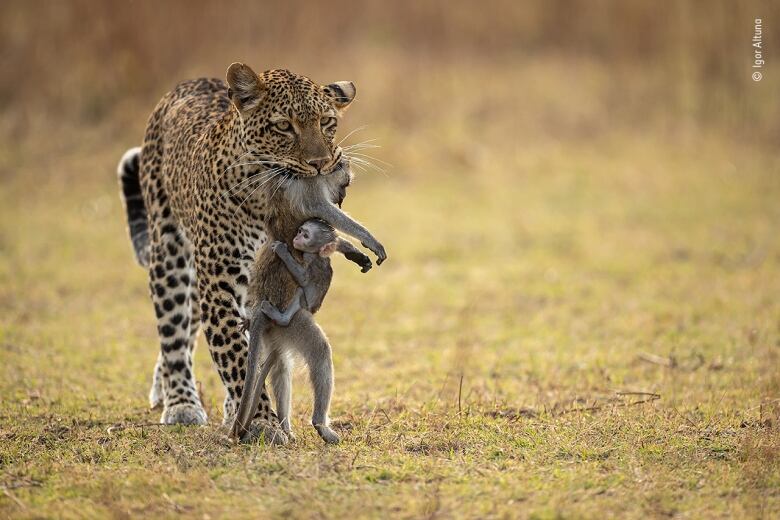A softer, gentler side of the Canadian wilderness is on display in the 2023 Wildlife Photographer of the Year People’s Choice awards.
A baby polar bear frolicking in a field of flowers in northern Manitoba, and two foxes sharing a tender nuzzle on a cold P.E.I. day were among the magical moments captured by this year’s Canadian finalists.
More than 60,000 people voted in the annual competition, which is run by the Natural History Museum in London. Two Canadians were among the four “highly commended” finalists: Martin Gregus of Vancouver and Brittany Crossman of Riverview, N.B. First place went to Sascha Fonseca of Germany.
A ‘little goofball’ named Beans
The photo by Gregus shows a baby polar bear — nicknamed Beans — playing in a field of bright purple fireweed on a sunny day near Churchill, Man., a town known as “the polar bear capital of the world.”
Using a remote-controlled camera during 33-day trip to the area in 2021, he captured Beans just he poked his head above the flowers, his eyes closed as if taking in the sounds and smells around him.
“He kind of pulled on our heartstrings the entirety of the time. He was a little goofball,” Gregus told As It Happens host Nil Köksal. “For him to be in that picture is even more special.”

It’s the kind of photo you get by spending a lot of time with the bears, getting to know them, and building trust, Gregus said.
He recalled that on one of his visits in 2020, a mama bear conscripted him and his colleagues into “babysitting duty.”
“The mom kind of came by with her cubs and she nursed, and the cubs fell asleep and the mom just left. And she didn’t just leave like a few metres. She walked off like 5,000 metres away,” he said.
“They kind of stayed and they went to our camp a little bit and they played and they fell back asleep. And it was like two or three hours later she came and picked them back up, and then they all walked off together.”
Gregus also won the Wildlife Photographer of the Year’s Rising Star Portfolio Award in 2021.
Unexpected intimacy
Crossman has been photographing foxes for years, but her shot of the canoodling critters took her by surprise.
She was taking pictures in North Shore, P.E.I., in March 2019 when she saw one fox approach another that was sitting along the tree line.

“Most of the interactions I’ve observed between foxes result in high-pitch screaming, tail wagging, bellies to the ground, then chasing or bickering on their hind legs,” she told CBC by email. “A territorial dispute or asserting dominance to the passerby.”
She readied her camera to catch the kerfuffle.
“To my surprise, they quietly greeted one another, sat side by side momentarily, exchanged a couple intimate nuzzles, then both carried on in separate ways,” she said.
“It is a tender moment shared between two individuals that I’ll never forget.”
‘Ghost of the mountains’
The winning photograph in this year’s competition takes us far from Canada, to the mountains of Ladakh in northern India.
It was there that Germany’s Fonseca captured his image of a snow leopard set against a stunning backdrop of snow-capped mountains and a bright pink sunset.

The image was the hard-earned product of a three-year bait-free camera-trap project to document the sleek mountain predators.
Snow leopards are notoriously difficult to photograph because of their stealth, camouflage, remote territory and, sadly, dwindling numbers. The National History Museum estimates there are only about 6,500 adult snow leopards left in the wild, and they face threats from poaching, habitat loss and human-animal conflict.
“Photography can connect people to wildlife and encourage them to appreciate the beauty of the unseen natural world,” Fonseca said in a press release.
“I believe that a greater understanding of wildlife leads to deeper caring which hopefully results in active support and greater public interest for conservation.”
More big kitties — and their unwitting prey
The snow leopard wasn’t the only big cat on display in the contest. And not all the selections were as soft and sweet as the Canadian shot — so be forewarned, this next one is more intense.
Igor Altuna was honoured for his photo of a leopard huntress carrying a monkey she had just slain. The prey’s baby, still alive, was clinging desperately to its mother’s corpse.
Altuna told the Natural History Museum that he watched the predator calmly carry the terrified baby to her own cub, who played with it for an hour before making the kill.

Spain’s Marino Canio was honoured for portrait of Olobor, a powerful and grizzled lion in Kenya’s Maasai Mara National Reserve.
“All around the lion, the ground was black, having been burnt by local Maasai herdsmen to stimulate a new flush of grass,” the museum’s photo description reads.
“Marina wanted to capture his majestic and defiant look against the dark background and lowered her camera out of her vehicle to get an eye-level portrait.”

Wildlife Photographer of the Year is developed and produced by the Natural History Museum in London. The titular prize will be chosen by a panel of judges in October.





More Stories
Fair share: the right office solution can take finding the right partner
Ontario faces crew shortages, aircraft issues in fight against wildfires | Globalnews.ca
Refugee attends open house at Downtown Eastside affordable housing facility – BC | Globalnews.ca